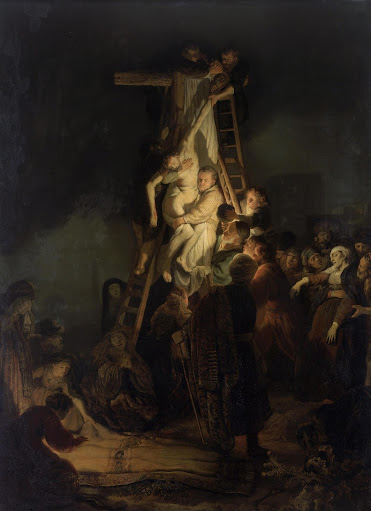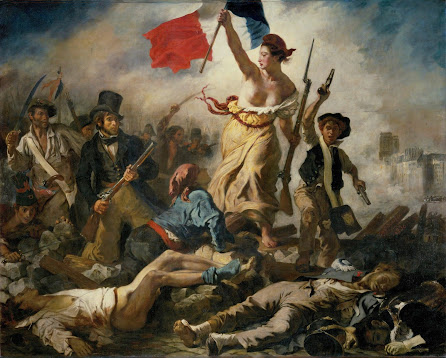Northern Renaissance: Bosch's Garden
 |
| Hieronymus Bosch, The Garden of Earthly Delights, oil on oak panels, 1505 |
The work is a triptych, oil paintings created on three hinged wooden panels, the two outer panels folding in on the inner panel. What is surprisingly rarely discussed is the fourth panel of the triptych, only viewable when the outer panels are closed.
 |
| Hieronymus Bosch, The Garden of Earthly Delights (closed) |
Starting with the triptych closed is how I believe that Bosch intended the work to be viewed, as it appears to be the beginning of the story the work is telling, the origin and fall of man. On the outer panels, you can see a gray landscape, made up of strange, misshapen, and abstract landscape on the left slowly changing into more realistic rolling hills and trees on the right. This symbolizes God shaping and creating the Earth in the beginning. You can even see him in the upper corner of the left panel, sitting in the clouds with one hand raised and the bible in the other.
The first panel on the inside of the work is a depiction of the Garden of Eden, picturing Adam, Eve, God, and a menagerie of animals and plants surrounding them. The second inner panel is where things begin going off the rails, depicting humanity committing all sorts of debaucherous and sinful acts, gluttony, lust, violence, the whole nine yards. Then, in the final panel, hell finally breaks loose. Literally. The colors dramatically shift from greens and blues to blacks and reds, depicting scorched buildings silhouetted by smoke and fire in the background seeming tame compared to the violence happening in the foreground, people are devoured by rats, swallowed whole by monstrosities, and subjected to all manners of torture and body horror.
It's my belief that The Garden of Earthly Delights is Bosch's condemnation of Humanistic values, his beliefs that religion and belief in god take precedent over all else clashing with Humanism's attachment of prime importance to Man rather than the divine, and the triptych is a depiction of the damnation waiting for those that put themselves above God.
Sources:
Fraenger, Wilhelm. The Millennium of Hieronymus Bosch: Outlines of a New Interpretation. Univ. of Chicago Press, 1951.
“The Garden of Earthly Delights by Bosch (Article).” Khan Academy, Khan Academy, www.khanacademy.org/humanities/renaissance-reformation/northern/hieronymus-bosch/a/bosch-the-garden-of-earthly-delights.
“The Garden of Earthly Delights.” Artble, 19 July 2017, www.artble.com/artists/hieronymus_bosch/paintings/the_garden_of_earthly_delights.



I love how much is going on in this paining. The more you look, the more you see. It reminds me of a "Where's Waldo" painting! The combination of different biblical stories really brings it together, and shows the bigger picture, not just a single moment from the Bible. It really has aged well, and I also really like the clashing colors from the divided scenes, and how they portray what the artist thought life would be like with and without god.
ReplyDelete